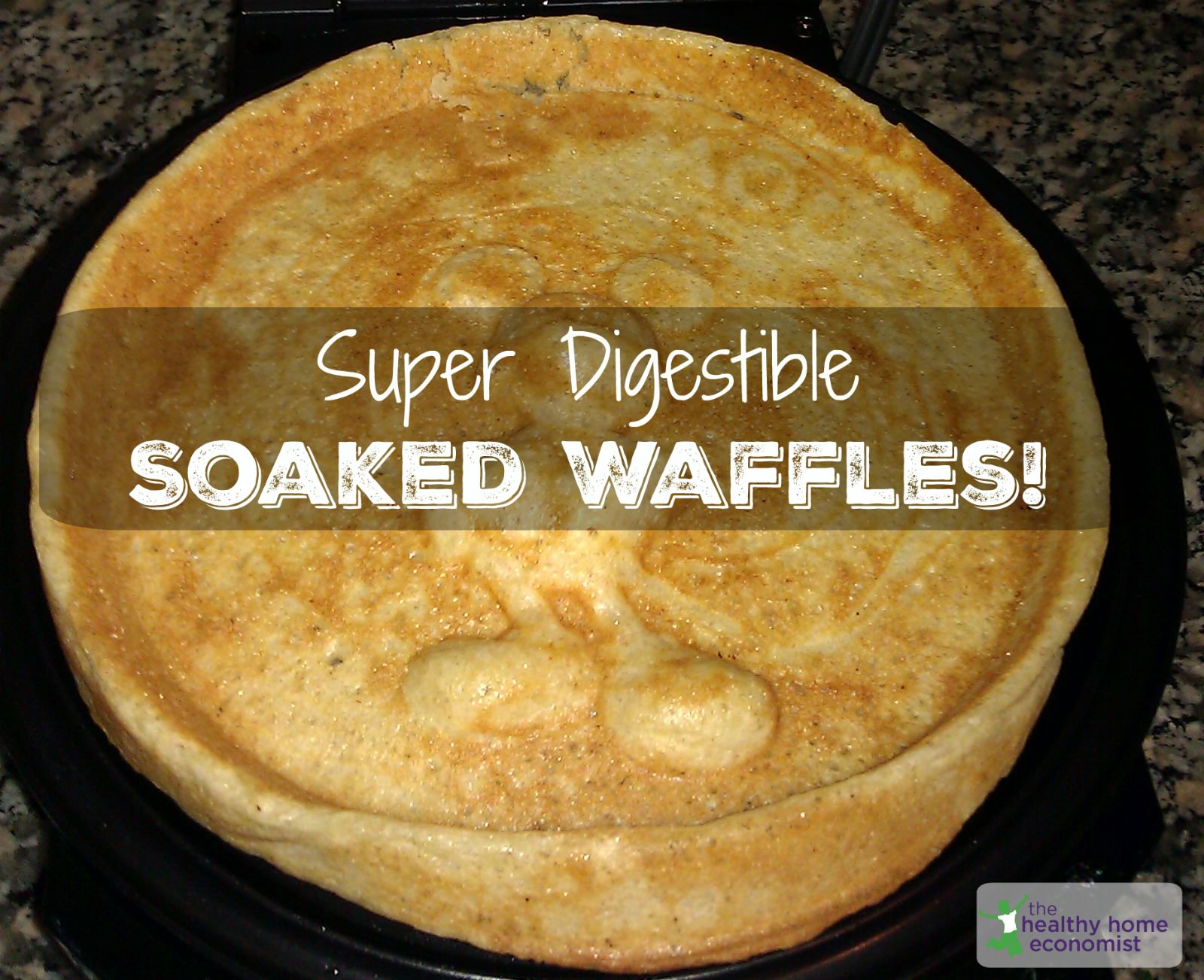 One of the holiday traditions in our home is eating soaked waffles on Christmas morning after all the presents have been opened. In past years, I have always used the waffle recipe from Nourishing Traditions cookbook. I dutifully soaked the freshly ground, whole wheat, einkorn or spelt flour in buttermilk, yogurt, or kefir the night before and whipped up the batter in the morning.
One of the holiday traditions in our home is eating soaked waffles on Christmas morning after all the presents have been opened. In past years, I have always used the waffle recipe from Nourishing Traditions cookbook. I dutifully soaked the freshly ground, whole wheat, einkorn or spelt flour in buttermilk, yogurt, or kefir the night before and whipped up the batter in the morning.
While the NT recipe is delicious, my husband always felt like the waffles were a bit heavy on his stomach and didn’t find them all that easy to digest even when soaked overnight in some sort of cultured dairy. I even tried soaking for a full 24 hours one year, but this did not seem to improve the digestibility at all as compared with an 8 hour, overnight soak.
This time I tried something different. I followed Rami Nagel’s suggestions on how to prepare wheat for optimized digestibility. Rami is the author of Cure Tooth Decay fame. The method I used was based on a conversation Rami and I had at the Wise Traditions 2010 Conference.
That chat really set me back on my heels as Rami told me that whole grains contribute to cavity issues and that soaking flour in cultured dairy really does not break down the phytic acid, lectins and other anti-nutrients or improve digestibility that well according to his research.
Soaking in water plus an acidic liquid such as lemon juice, vinegar, or liquid whey apparently breaks down these little nasties much much better.
According to Rami:
Calcium when souring reduces how much phytic acid is removed. So if a grain is soured with too much calcium, such as milk or yogurt, not as much phytic acid will be removed.
Homemade Soaked Waffles
Below is the recipe I came up with using Rami’s suggestions for super digestible, nutrient dense, healthy waffles.
The verdict? The kids said the waffles tasted the best ever and my husband said they were very light and easy on his stomach! In fact, he said that waffles prepared this new way were as easy to digest as his typical, non grain based breakfast.
Looks like I will be preparing my waffles using this new and improved method from now on! One other tip from Rami to keep in mind is that when soaking grains, the temperature needs to be kept at 70-85F otherwise phytic acid breakdown will be hindered.
Want to try this even more digestible, traditional waffle recipe on your family? Here’s how I incorporated Rami’s suggestions using the Nourishing Traditions’ basic waffle recipe as a guide.

Traditional Soaked Waffles Recipe
Recipe for the traditional method of making soaked waffles so that get full faster, eat less and stay satisfied all the way to lunch.
Ingredients
- 4 cups flour freshly ground is best
- 2 cups filtered water
- 2 Tbl lemon juice fresh squeezed is best
- 2 egg yolks lightly beaten, preferably from pastured eggs
- 2-4 Tbl maple syrup dark or Grade B
- 2 Tbl butter melted, preferably grassfed
- 1 tsp vanilla extract
- 1 tsp sea salt
- 4 egg whites
- expeller pressed coconut oil to grease waffle iron
Instructions
-
Sift 4 cups of fresh flour to remove most of the bran. This should result in about 2 1/2 cups of sifted flour. Add the discarded bran to your compost pile or feed to your chickens or other birds.
-
Mix 2 1/2 cups of sifted flour with 2 cups filtered water plus lemon juice. Cover with a cloth secured with a rubber band and let sit on the kitchen counter for 8 hours or overnight.
-
After soaking is complete, drain off any excess water that has come to the top. Blend in maple syrup, egg yolks, vanilla, salt, and melted butter.
-
In a separate bowl, add pinch of sea salt to egg whites and whip them until stiff peaks form. Pour whipped egg whites into batter and blend until smooth.
-
Cook in a hot waffle iron oiled with coconut oil.
-
Serve with plenty of raw, grassfed butter and Grade B maple syrup.
Prefer Sprouting to Soaking?
Do you prefer sprouting vs soaking as a traditional method for preparing grains? If so, check out this recipe for sprouted Belgian waffles using the sprouted flour of your choice.
Eat Paleo? Here’s a gluten free waffle recipe that is also grain free!
Sarah, The Healthy Home Economist








Sarah,
When soaking, is it okay to use a loose fitting lid instead of the towel and rubber band? I have them for the bowls I typically use for this. Didn’t know if there was a particular scientific reason.
Thanks!
Beth
You can use a lid.
We use a fantastic waffle recipe that is made of oats, water, coconut milk, raisins, flax seeds, cinnamon, and grapeseed oil. Lately, I have been adding cashews, almonds, and sunflower seeds. Really, you can add whatever you like. You just blend all the ingredients in a blender and then pour on to the waffle maker. Then we put real butter and honey to top it off. Yummy!
If you would like, I can post the recipe.
Love it! Please do post, Melissa or send to me by email with a picture and I can put up as a guest blog. thehealthyhomeeconomist@gmail.com
nice post. thanks.
another option for non-teflon waffle irons is to try to find an old one (before they started using teflon, but after cast iron) on ebay. i got mine for less than $20 and it was used very little. not sure how great the metal is, i think it’s either aluminum or some kind of stainless blend or something, but whatever it is, it’s better than teflon to me, and easier to use than the cast iron ones over the stove. those early electric appliances are like energizer bunnies – they never wear out!
Thanks so much for the reply, Sarah. Yes, there is always soooo much to learn…and adjust. I think I’ll give your cereal recipe a try today!
Thanks again!
Christi
Hi, Sarah. I love your blog; you always have such informative posts –thank you!
I just watched your homemade cereal videos and was wondering if what you’re saying here would apply to the soaking for your cereal. Meaning, are you planning to stop soaking your flour in soured milk and start using water with acidic medium (lemon juice, liquid whey, etc.)?? Just curious before I get started making it myself.
Many thanks!
Christi
Hi Christi, yes – I do plan to start sifting the flour for my cereal and soaking in water plus lemon juice or whey instead of clabbered milk. We are always learning, aren’t we!
I want to try this, but have just gotten home from vacation. I have a question about sifting the flour to remove the bran. When I grind white wheat in a NutraMill, it all has the same consistency, so how does the bran separate out? Since no one else questioned this, maybe I am missing something very obvious. I will try sifting my flour, but I think it will all go through the sifter.
Thanks for all your information – it is greatly appreciated. I keep going back to articles you have written when I start questioning. Thanks again.
The Nourishing Our Children campaign’s Facebook supporters had ideas for non-teflon waffle irons: http://www.facebook.com/permalink.php?story_fbid=178494982171575&id=165679030171
When I started soaking flours, my husband was convinced that looking at raw milk would kill him (he has since tried it twice- the first time being straight cream since he didn’t know to shake it… his reaction was priceless!), and I’m rather uncomfortable with using pasteurized dairy even if cultured. So, I used coconut milk with whey. It makes for a rather heavy pancake, but OMG so good! Neither of us ever liked pancakes much, but these are a super special treat every few weeks or so.
I don’t think coconut milk has much if any calcium, so I guess that’s ok? Even if it’s not, it’s the best pancakes I’ve ever had, and we only have them occasionally.
I learned so much from this post, not least of all how to make nutritious waffles which is wonderful! Thank you!